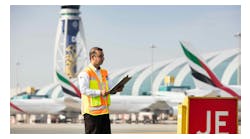Why Anchorage's International Airport is Such a Big Cargo Destination -- and How It Could Get Even Bigger
May 16—Cargo traffic through Ted Stevens Anchorage International Airport surged during the COVID-19 pandemic, with scores of jets arriving daily from Asia.
They brought with them computers, cell phones, pharmaceuticals and other products in high demand from homebound people in the Lower 48, airport officials said.
Jets headed the other way hauled Canadian lobster, Washington state cherries and more, airport director Jim Szczesniak said during a recent airport tour.
"There's the lobster plane," he said, nodding to a Sky Lease Cargo jet.
Altogether, the airport landed 3.2 million metric tons of cargo last year, a 15% increase as e-commerce boomed along the world's busiest trade route — from Asia to the U.S.
The Anchorage airport's growth far outpaced the competition, making it the world's fourth-busiest for cargo, up from sixth place.
Despite that growth, the airport lacks the services of its competitors, Szczesniak said.
It's largely a fuel stop and crew-change site for the jumbo jets headed to other airports.
But a series of projects proposed for the airport, valued at $1 billion, could help transform it into more of an all-purpose stop for cargo jets, he said.
For the first time, giant new warehouses would allow any of the airport's nearly 30 international carriers, such as China Airlines or Korean Air, to stockpile items for efficient shipment.
As it is now, cargo jets occasionally meet on the tarmac to trade products, limiting options and requiring coordination, officials said.
Another proposal for a cold-storage facility, part of a $200 million project, could increase shipments of frozen or perishable goods, including seafood from Alaska.
FedEx and UPS, which operate freight-sorting hubs that move about one-fourth of the airport's landed cargo, also plan large expansions, airport officials said.
The projects were announced starting in 2019 as developers pursued leases for raw land around the airport. They are now in various phases of design and engineering, he said.
They represent the airport's most significant chance for growth in cargo services ever, he said.
If built, they'd provide hundreds of jobs, serving as a potential counterweight to Alaska's struggling economy.
"We are full-throttle trying to maximize this asset to pull ( Alaska) out of this decline," Szczesniak said.
A perfect spot
Perched midway between Hong Kong and the Lower 48, the Anchorage airport is geographically blessed for cargo service, said Darren Prokop, an economist and logistics professor at the University of Alaska Anchorage.
Cargo jets can fly right over Anchorage if they choose, he said.
But they can instead gas up at the airport, allowing them to carry less fuel and more of the cargo they're paid to haul.
That aviation fuel is relatively cheap, because the airport is part of a foreign-trade zone administered by the nearby Port of Alaska where the fuel arrives. That means the fuel avoids duties that can boost prices elsewhere, said Prokop.
The airport enjoys another advantage over competitors, Prokop said. Unlike airports elsewhere in the U.S., foreign carriers can legally transfer cargo between jets at the Anchorage airport. The exemption was secured by the late Ted Stevens in 1996 and enhanced in 2004, he said.
Carriers have been reluctant to take advantage of that. They worry it might be illegal in Anchorage because it's illegal elsewhere, he said. Also, it requires timing jets' schedules.
"Hence the cargo facilities," Prokop said.
If the new facilities are built, foreign jets can still transfer product without having to worry about making sure the other jet has arrived. And they can do it more efficiently, at more convenient times, at the cargo facilities.
Prokop said that long-term, the airport should see continued gains in cargo because of the strong demand in the U.S. for products from Asian countries.
"We are the gateway city to the Lower 48," he said.
During the pandemic, cargo flights from a growing number of Asian cities began passing through Anchorage. To haul products to the Lower 48 faster, they bypassed big hubs such as Shanghai or Hong Kong, Szczesniak said.
What will happen as the pandemic eases is uncertain.
Szczesniak said he thinks changing route patterns and continued growth in e-commerce are factors that will help supplant the pandemic-related issues that boosted cargo to Anchorage.
"The pandemic has cemented the importance of Anchorage in the global supply chain," he said.
A full-service stop
John Tichotsky, a former chief economist for Alaska, is a partner in IC Alaska. The company plans to build a maintenance hangar to provide mechanical work for jumbo jets at the airport's southern end.
The hangar is part of a $500 million proposal that also includes new cargo storage and sorting space. Also, 14 "hard stands" would allow cargo jets to fuel up, plug into power and transfer freight.
The project will change the airport from the equivalent of a standalone gas pump into a full-service station, Tichotsky said.
Lease negotiations for the land at the airport are being finalized, he said. The hard stands could open as early as next year.
"I can't identify anything (in Alaska) that will come online faster and produce greater economic benefit than providing infrastructure at the airport," Tichotsky said.
Other projects are:
—FedEx plans to expand its existing operation by 19 acres, building a new center to sort domestic freight, part of a $60 million project. International freight sorting will continue in the current transfer center.
—6A Aviation has proposed building a 195,000-square-foot warehouse and six parking spots for cargo jets, a $170 million project on the airport's west side.
—Alaska Cargo and Cold Storage plans its $200 million warehouse off the north-south runway, with cold storage.
—UPS plans to expand its existing facility by 28 acres, and add space for three big cargo jets, a $110 million project.
The UPS expansion will take up much of the northern portion of the airport, Szczesniak said.
"This will all be one big, giant UPS campus," he said during the tour, pointing to a stretch of raw land that extended to a hill.
Construction for the cold-storage project could start later this year, officials said.
Beside supporting international businesses, cold storage could help Alaska companies that want to ship seafood or peonies, said Joe Jacobson with McKinley Capital Management, a project partner.
The plan is to capitalize on the traffic that currently exists at the airport. Any growth would be a bonus, he said.
"Right now there is unrealized opportunity just with the existing traffic," Jacobson said.
A bright spot
The cargo industry was a bright spot in Alaska last year, as the pandemic battered other sectors, said Bill Popp, head of the Anchorage Economic Development Corp.
Among other benefits to Anchorage, it brings hundreds of cargo pilots daily who help fill hotels and support restaurants. (A cargo plane pilot was Alaska's first confirmed positive case of COVID-19 on March 11, 2020.)
Cargo activity is responsible for much of the employment at the airport. The airport supports about 10% of the jobs in Anchorage, he said.
Recently, FedEx announced it is hiring more than 200 workers to create its first permanent night shift for package-sorting at the airport.
Popp said there's optimism that cargo in Anchorage will stay strong, increasing the odds the projects will be built, he said.
Prokop, the logistics professor, said the new warehouses might one day support new manufacturing businesses in Anchorage. Parts stored at the airport could be assembled into final products that can be shipped elsewhere.
"Ten or 20 years from now, we'll see if this leads to value-added manufacturing," he said.
___
(c)2021 the Alaska Dispatch News (Anchorage, Alaska)
Visit the Alaska Dispatch News (Anchorage, Alaska) at www.adn.com
Distributed by Tribune Content Agency, LLC.



